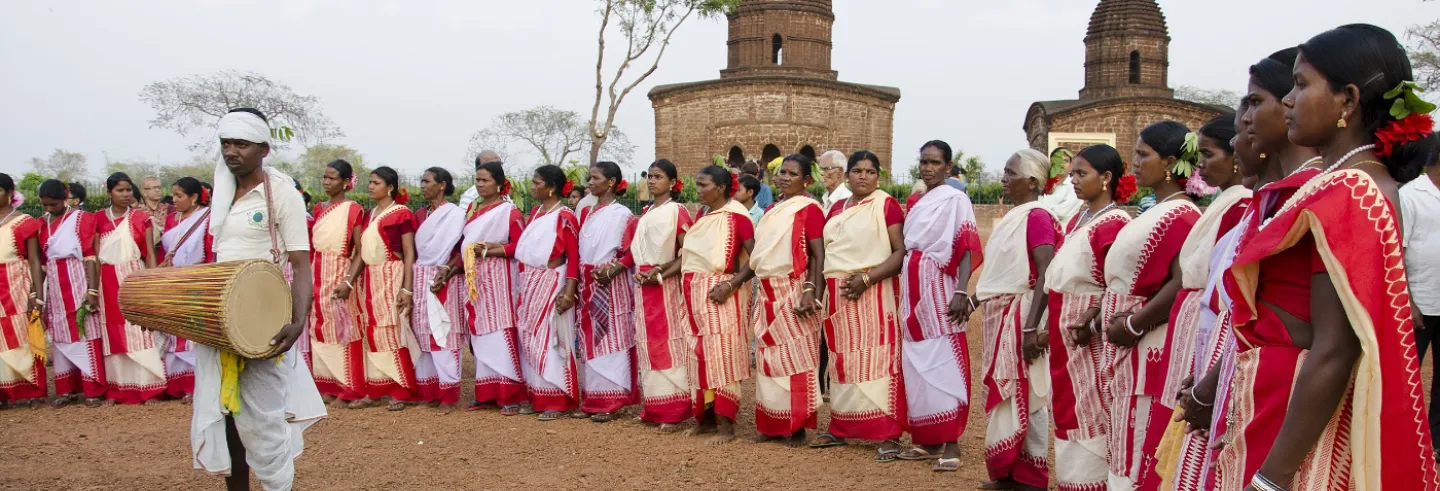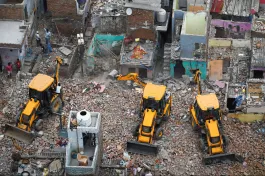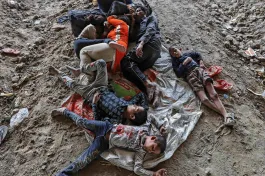On Nishu’s first day as an assistant in the district court in Gumla, Jharkhand, a judge dismissively flung the paperwork of a newly hired Scheduled Tribe member of the staff, exclaiming, “How will I make them work?” Nishu was shocked. If a senior member of the judiciary held such attitudes and beliefs about Adivasis, what could be expected from others?
Like many indigenous communities in India, Adivasis in Jharkhand have experienced—and continue to experience—numerous forms of discrimination and violence, which have been the result of decades of colonisation, racism, migration, urbanisation, and social exclusion. This has left them in a tenuous position, socio-economically and politically (Sharma 2018).
State development projects in the post-Independence years, such as the building of educational institutions, hospitals, and dams, were expected to create unskilled and semi-skilled job opportunities for Adivasis, while the Joint Forest Management Act (1990) was intended to protect their rights to the forest. However, neither the benefits of the development projects nor the protections of the Act were distributed equitably, creating disempowerment, economic inequality, and instability within the community (Munshi 2013; Rath 2009). Further, as jobs and opportunities favoured men, these policies disadvantaged Adivasi women (Rath 2009).
We interviewed eight Adivasis, five of them women. They all resided in Ranchi, Jharkhand, and represented the three largest tribal groups in the state – Santhal, Oraon, and Munda.
All these changes made traditional tribal livelihoods increasingly untenable and hastened the migration of Adivasi families to urban areas (Kujur and Mishra 2020). But while urbanisation has offered Adivasis new opportunities for education and work, it has also contributed to the decline of their culture and the gender egalitarianism seen in their communities (Noy 2020). Additionally, urban life has brought new challenges to do with the “outside” or “mainstream” world—Adivasis who have studied and worked in cities have faced new forms of discrimination and violence, ranging from verbal abuse to exclusion (Kamat 2008).
To better understand the experiences of urban Adivasi youth, we reached out to men and women between the ages of 18 and 29 through professional and academic networks. We interviewed eight Adivasis, five of them women. 1All names used here are pseudonyms. They all resided in Ranchi, Jharkhand, and represented the three largest tribal groups in the state - Santhal, Oraon, and Munda. At the time of the interviews, none of them had partners; three were in college, two were employed, and three were looking for work or preparing to study further.
Five of the respondents were long-term urban residents because their families had migrated to the city a generation or two ago. The remaining were the first members of their family to live in a city. They were asked to reflect on their urban lives in terms of their interactions with the non-tribal world (educational settings, workplaces) and within the home. The interviews were conducted by the first author, who is herself of Adivasi origin.
Interacting in urban Spaces
Studies suggest that Adivasis are routinely victimised by mainstream institutions and systems (Dhal 2018). Almost all the respondents echoed this finding. They said that once they were identified as Adivasis by their names, appearance, or attire, they were treated differently by those who lacked an awareness of their culture and lifestyle. They pointed out that their underrepresentation in administrative and service-providing institutions and exclusion from positions of power led to challenges in accessing critical services, such as healthcare, education, sanitation, and legal assistance. When they fought for their rights or demanded representation, some respondents felt that non-Adivasis responded with hostility.
Most of the Adivasis felt that urban life promoted individualism and competition, and described how inequities in education, training, and employment created economic inequality and social stratification within their communities. They also felt that mainstream urban life undermined their own culture, which valued cooperation, equal rights, and opportunities.
In addition to the effect urban life has had on Adivasi culture, studies suggest that gender norms in Adivasi communities have been particularly disrupted by urbanisation.
Viraj (23) said that “city life had caused traditional community values and practices to gradually erode”. For instance, Santhal weddings, which used to be modest and unpretentious events in his village, had been replaced with lavish ceremonies intended to show off wealth. He observed that the “tight social closeness that distinguished tribal groups was often broken by people living with strangers.” The differences in the lifestyles and social mobility of those who were employed in the city bred resentment in those who remained in the villages and weakened community relations.
In addition to the effect urban life has had on Adivasi culture, studies suggest that gender norms in Adivasi communities have been particularly disrupted by urbanisation. The development policies that initially drove urbanisation were disadvantageous to Adivasi women, and today’s urbanisation has made conditions worse for them. As men moved to cities seeking work, women have often joined them as housewives. Their life in the city is different from their lives back in their villages, where most women participated in the community’s economic life (Noy 2020). Our interviews suggest that even when educated or employed, Adivasi women and men experienced urban educational spaces, workplaces, and even home life differently, with women being disproportionately likely to experience discrimination and harassment.
Educational Institutions
In both negative and positive ways, all the respondents felt that their identity as Adivasis had a significant influence on their educational experiences. Nishu (29) described how Adivasi students felt discriminated against in schools and colleges because educators routinely differentiated between tribal and non-tribal students, grouping them accordingly in classrooms and for different activities. Renee (23) said schoolteachers saw tribal students as educationally backward, and paid less attention to them in the classroom. “Teachers felt that I would not be good at my studies because I came from a tribal background,” she said. “They could identify us from our name and did not pay attention to us.”
Some of the Adivasis shied away from identifying themselves as tribals, and preferred to identify themselves in other terms. Viraj said, “In college, I used to have an inferiority complex when I said I was from a tribal background. So, now I do not like to introduce myself as tribal, but prefer introducing myself as a Christian. I am still a tribal, but I can’t take pride in being a member of a Scheduled Tribe.”
Women felt much more than men that they were being judged on the basis of their Adivasi identity. The men were better able to find ways to either sidestep the issue or recast it in a different light.
Though their status as tribals was an obstacle to some, others said that a few instructors had found ways to accommodate their needs and tried to make their educational journey easier. “Instructors were liberal with us. They taught us in both English and Hindi, and assigned different assignments for each course. We were trained by them and supported by our friends to write and explain things in the language we were comfortable with,” said Vimal (25 yrs.).
For all respondents, their Adivasi identity was central to their educational experience. But whether it was a positive or negative experience depended on the gender of the respondent, with women more likely to describe being ignored or underestimated. Women felt much more than men that they were being judged on the basis of their Adivasi identity. The men were better able to find ways to either sidestep the issue or recast it in a different light.
Workplaces
Adivasi women were quick to describe the discrimination and harassment they experienced at work, mostly by their non-Adivasi colleagues and supervisors. For instance, both Nishu and Simmi (27 yrs.) were subjected to inappropriate comments about their appearance, body, and clothing. Nishu had been advised to lighten her complexion and improve her appearance by trying different skin treatments at a beauty parlour.
Often the harassment was implicitly sexual in nature. For instance, when Julie (29 yrs.) began working as a nautical officer, another officer suggestively commented, “What is this company doing? They have put the lamb in the wolf’s mouth.” At other times, the sexualisation was obvious. Simmi saw her senior colleagues making obscene physical gestures in her presence, and described their behaviour at the workplace. “They shared inappropriate images and videos and created a hostile work environment. In the beginning, everyone was sweet to me, but later on I realised that they were expecting something [sexual] from me.”
In a case drawn from another study, the hostile and sexualised environment developed into a sexual assault. An Adivasi woman described how a former supervisor made her feel increasingly uncomfortable as he sought her out for company, forced her to stay late at work, and made sexually charged remarks in her presence. He ultimately molested her. They were not subject to such behaviour or expectations from only men. Nishu overheard a senior female colleague remark, “Tribal women are of a loose character; they are available for sex.”
In schools and colleges, the discrimination faced by Adivasi students largely centred on their assumed abilities but in workplaces women were disproportionately harassed about their physical appearance and perceived sexual habits.
The women respondents said that they were rarely treated as equals or judged on the basis of their position, performance, or work ethic. Nevertheless, they were asked to take on additional duties. They were routinely subjected to verbal and non-verbal harassment and discrimination, all centred on their gender and tribal identity. If they resisted such behaviour, the harassers further discriminated against them by initiating formal complaints. Simmi and the other women felt that such experiences were unavoidable and that they had few options but to tolerate them.
As with educational institutions, workplaces were far more challenging for women than men—but for different reasons. In schools and colleges, the discrimination faced by Adivasi students largely centred on their assumed abilities but in workplaces women were disproportionately harassed about their physical appearance and perceived sexual habits.
At Home
Living in a “mainstream” urban society, the Adivasis experienced gender discrimination not only outside the home, but also in it. Though they recognised that Adivasi communities were not wholly gender egalitarian in their villages, almost all the women respondents felt that the urban environment had worsened gender relations within the household.
While men had the opportunity to travel and live in different places for education or work, women experienced restrictions on mobility. They were confined to a limited geographical area or allowed to go outside it only with a family member escorting them. The men were aware of this disparity. “As a boy I was not restricted from going out for my education, but my sister was, because of safety issues,” said Jagan (23 yrs.).
Anjana observed that the division of household work in cities was unfair, with women working outside the home and also being primarily responsible for the household. Nishu cited the example of her mother, a government schoolteacher, who had to manage everything with little support from the male members of the family. “My mother did the early morning work, prepared breakfast, and then dropped us at school before she left for her school. She managed to do everything alone. She hardly received any support until we grew up.”
Further, as the Adivasis have become used to “mainstream” living, it has led to a dilution or even loss of their traditional knowledge and cultural practices, rituals, and traditions.
It was not the same for male members of the family, who tended to be less committed to the household in urban settings. Anjana (28 yrs.) commented that her brother’s contribution to the household “depends on his mood. I can’t say he contributes much but he does go out to purchase small things.” Even when both men and women contributed to the household, the women performed the more demanding indoor chores (cooking and cleaning), while the men performed the easier chores that took them outside the home (shopping).
Conclusions
“My tribal identity troubles others despite my equal qualifications. We are sidelined and often experience discrimination in different spaces and at different levels,” Nishu said. Her complaint was echoed by the other respondents as well, who found it difficult to converse with city folk and participate in “mainstream” activities. As a result, they felt socially excluded and marginalised, and had limited access to resources and opportunities.
Anjana described how many Adivasis “experienced unfair treatment or were refused access to services due to stereotypes based on their ethnicity or indigenous identity.” She noted that “policies and services had failed to appropriately address the unique needs and worries of the tribals.” Further, as the Adivasis have become used to “mainstream” living, it has led to a dilution or even loss of their traditional knowledge and cultural practices, rituals, and traditions. Several respondents felt that the loss of their cultural identity contributed to a sense of rootlessness, making it challenging for them to advocate for themselves.
While a tribal identity functioned as the primary axis of discrimination outside the home, gender was the primary source of discrimination inside it. Adivasi women were particularly vulnerable in negotiating life in urban settings, doubly disadvantaged by both their tribal identity and their gender. They were more likely than men to be overlooked and ignored in school and college by their instructors who had stereotypical views.
Our work suggests that formal affirmative action policies such as reservation quotas, which are intended to increase the representation of Adivasis in educational institutions and workplaces, are insufficient to address the real discrimination that Adivasis face.
In workplaces, Adivasi women were singled out for mistreatment and discrimination based on their appearance and beliefs about their behaviour. Despite their secure formal sector jobs, they were sexualised and subjected to comments on their skin colour, physical appearance, and clothing. The harassment sometimes became overtly sexual. Adivasi women were assumed to lack a good work ethic but at the same time given more than their fair share of work. Few of the men reported similar experiences.
Within the urban nuclear family—an institution at odds with the extended families that characterise traditional Adivasi societies—Adivasi women faced limits on their educational and professional growth because of entrenched cultural norms that prioritised men’s education and employment. Such experiences, which illustrate how patriarchal ideologies are deeply embedded in the social fabric of mainstream and Adivasi societies, became even more evident in urban settings.
The Way Forward
Decades of development projects and laws have had an impact on Adivasi communities and gender relations within them, and continue to shape the lives of those who have migrated to urban areas. Their tribal identity plays a significant role in the experiences of young Adivasis in urban India, and urbanisation has strained traditional Adivasi norms because of pressures from outside the community and from within it.
This study shows that burdens of urbanisation are largely borne by women, but it remains unclear how and why Adivasi men are better accommodated by mainstream society. While this study was conducted among the Adivasi youth in Ranchi, further studies must be undertaken to understand the experiences of youth from different tribal backgrounds and in other urban settings, with close attention to the issues of gender and social class.
Our work suggests that formal affirmative action policies such as reservation quotas, which are intended to increase the representation of Adivasis in educational institutions and workplaces, are insufficient to address the real discrimination that Adivasis face. Additional research is needed to understand the long-term consequences of such discrimination on the lives of Adivasi youth. Developing a nuanced understanding of this issue is necessary to develop interventions that empower Adivasis in urban spaces, both formally and informally.
Kumari Vibhuti Nayak is an assistant professor of social anthropology at Center for Studies in Social Sciences Calcutta. Abha Rao is a public health researcher based at the Ramalingaswami Centre on Equity and Social Determinants of Health, Public Health Foundation of India.










